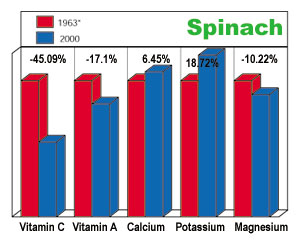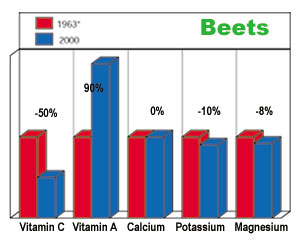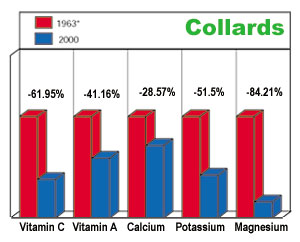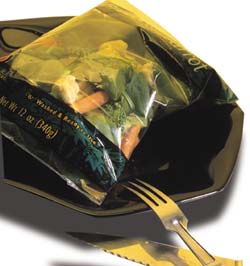Untitled Document
Imagine the surprise of going online and discovering that the vitamin
and mineral content of vegetables has drastically dropped.
That’s what happened to nutritionist, Alex Jack, when he went to check out
the latest US Department of Agriculture food tables. The stunning revelation came
after Jack compared recently published nutrient values with an old USDA handbook
he had lying around. Some of the differences in vitamin and mineral content were
enormous-a 50% drop in the amount of calcium in broccoli, for example. Watercress
down 88% in iron content; cauliflower down 40% in vitamin C content-all since
1975.
 |
Jack took his findings to the USDA, hoping for a reasonable explanation. That
was two years ago. He’s still waiting. So is Organic Gardening
magazine, which published an open letter, seeking an explanation from Dan Glickman,
Secretary of Agriculture. Glickman didn’t respond, but USDA employee,
Phyllis E. Johnson did. Johnson (who is head of the Beltsville area office),
suggested to Organic Gardening that the nutrient drain should be put
in context. According to her, the 78% decrease in calcium content of corn is
not significant because no one eats corn for calcium. She further explains that
the problem may not even exist at all; that the apparent nutrient dips could
be due to the testing procedures. For example, “changes in the public’s
perception of what the edible portion is may determine what parts have been
analyzed over time.” In other words, back when the old food tables were
made up, people may have been eating the cobb too, so they got more nutrients.
The vitamin drain
We decided to look into this further. Jack had used a 1975 version of the food
tables for his research. We dredged up a 1963 version. After comparing the nutrient
values for over a dozen fruits and vegetables, it was clear that the nutrient
value of many foods has dropped, in some cases drastically. For example, the amount
of vitamin C in sweet peppers has plummeted from 128 mg to 89 mg.= The vitamin
A in apples has dropped from 90 mg to 53 mg. The fall-offs seem to be limited
mostly to vegetables, and some fruits.
Some vegetables appear to be gaining vitamins-at least vitamin A. Carrots,
for example, have more of the vitamin now than they did in 1963. Why is a mystery.
But the phenomenon has apparently occurred just in the nick of time. The National
Academy of Sciences has issued an alert that it takes twice as many vegetables
to get the daily requirement of vitamin A as previously thought. Carrots and
pumpkin are exempt from the caveat.
 |
Despite the apparent increase of vitamin A in carrots, most vegetables are
losing their vitamins and minerals. Nearly half the calcium and vitamin A in
broccoli, for example, have disappeared. Collards are not the greens they used
to be. If you're eating them for minerals and vitamin A, be aware that the vitamin
A content has fallen from 6500 IUs to 3800 IUs. Their potassium has dropped
from from 400 mg to 170 mg. Magnesium has fallen sharply-57 mg to 9. Cauliflower
has lost almost half its vitamin C, along with its thiamin and riboflavin. Most
of the calcium in pineapple is gone-from 17 mg (per 100 grams raw) to 7. And
the list goes on and on.
The USDA refuses to act
What’s the deal on this nutrient drain? We decided to ask USDA ourselves,
so we contacted the head of the USDA Agricultural Research Service, whose job
it is to track the vitamins in food, among other things. Mr. Edward B. Knipling
responded to our inquiry with a restatement of Ms. Johnson’s letter to
Organic Gardening magazine. So we pressed for a better answer. Isn’t
the agency concerned that Americans may not be getting the vitamins they think
they are? What about the food pyramid? Won’t a nutrient drain upset the
pyramid? Already the National Academy of Sciences is telling us our vegetables
don't have as many vitamins as they're supposed to. Will the USDA double the
required servings of vegetables to make up for the vitamin loss? So far, no
answer from the agency.
 |
The question is, what is the nature and extent of the problem? Vegetables are
a major source of nutrition. Without them, humans miss out on important vitamins,
minerals and phytonutrients. Many nutrients (such as folate) weren’t measured
in the past. If they are also disappearing, the extent is unknown. What about
more exotic nutrients such as flavonoids, or compounds like I3C? These aren’t
tracked by the USDA. Are they disappearing also?
What’s for dinner
The USDA advises that we should be eating 3 to 5 servings of vegetables plus
2 to 4 servings of fruit a day to maintain health. (A serving is one cup of
something raw and leafy or one-half a cup of something either not leafy or cooked-or
3/4 cup of vegetable juice). That is potentially 9 cups of vegetables and fruit
a day. That’s a lot of lettuce. Are people doing this?
“90% of women and 71% of men get less than the RDA for
vitamin B6.” Dietary vitamin B-6 intake and food sources in the
US population: NHANES II, 1976-1980. Kant AK, et al. 1990.
“Men with the lowest amount of vitamin C have a 62% increased
risk of cancer and a 57% increased risk of dying from any cause.“
Vitamin C status and mortality in US adults. Loria CM, et al.
Am J Clin Nutr 72:139-45, 2000.
“Lutein and zeaxanthin reduce the incidence of cataract
by 22%.” A prospective study of carotenoid and vitamin A intakes
and risk of cataract extraction in US women. Chasan-Taber L,
et al. Am J Clin Nutr 70:509-16, 1999.
“People with low levels of retinol, beta-carotene, vitamin
E and selenium are more likely to get cancer.” Serum retinol, beta-carotene,
vitamin E and selenium as related to subsequent cancer of specific sites.
Comstock GW, et al. Am J Epidemiol 135:115-21, 1992.
“Supplemental vitamin D reduces the risk of colon cancer
by half compared to dietary vitamin D which reduces it 12%.” Calcium,
vitamin D, and dairy foods and the occurrence of colon cancer in men.
Kearney J, et al. Am J Epidemiol 143:907-17, 1996.
“The area of China with the lowest micronutrient intake
has the highest rate of cancer. Supplementation with vitamin E, selenium
and beta-carotene lowers the rate.” Vitamin/mineral supplementation
and cancer risk: internationaal chemoprevention trials. Blot
WJ. Proc Soc Exp Biol Med 216:291-6, 1997.
“American children have inadequate levels of vitamin E.“
Vitamin E status of US children. Bendich A. J Am Coll Nutr 11:441-4,
1992.
“Flavonoids protect against stroke.” Dietary flavnoids,
antioxidant vitamins, and incidence of stroke: the Zutphen study.
Keli SO, et al. Arch Intern Med 156:637-42, 1996.
|
Harry Balzer is vice president of NPD Group, a firm that gathers information
on the eating habits of Americans. His data says no way. According to him, the
preferred American meal is one-dish, already prepared. Unless a vegetable can
be squirted out of a bottle, it’s a nonentity. Why? We’re in a hurry.
Vegetables are considered side dishes, and Americans don’t have time for
such frivolity. The decline is relentless. Within the last 15 years, the percentage
of all dinners including a vegetable (other than salad or potatoes) dropped
10%. It’s now 41%.
This raises a big question. If people are not eating their vegetables, how
are they getting their vitamins? The answer is they’re not. Study-after-study
show that Americans don’t meet the RDAs for many nutrients. That’s
not good considering that RDAs are probably too low to keep most people in optimal
health to begin with.
Americans know what they should be eating. They’re just not doing it.
And they’re not likely to. According to Balzer, for example, pizza is
one of America’s favorite meals. It fulfills, he says, the American ideal
of being easy and fast, liked by old and young, and easy to clean up. If you
blot it with a paper towel, throw on some pineapple, and use your imagination,
it even seems to fit with the food pyramid. What else are people eating? Bread,
doughnuts, pasta, cheese, beef and milk. Without fortified cereal, Americans
would not come close to meeting RDAs.
Yes, but what about the produce section? Isn’t it filled with resealable
bags full of wholesome, scrubbed little carrots, prewashed salad greens and
spinach? Somebody must be buying them, or they wouldn’t be there, right?
According to Balzer, those puppies are highly successful, raking in a billion
dollars in sales ($100M is considered successful for a new food product). But
the fact that people are buying them doesn’t mean they’re eating
them. The reality is that onions are most-often served vegetable in America.
Tomatoes (including ketchup) are second.
According to one study, less than one-third of Americans get the minimum five
servings of fruits and vegetables a day, let alone the recommended nine. According
to Balzer’s data, the percentage of Americans who buy healthy groceries
is about 10%. The other 90% relies on ketchup, onions, fat-free snacks, ice
cream, cheese and Sweet Tarts™ as their source of nutrition. Now we find
out that even if a person accidentally eats a vegetable, it may not contain
the nutrients it’s supposed to. What can a person do?
Vitamin supplements work
 |
|
"...the nutritional content of produce is not as important as things like appearance and big yield. In other words, the view of commercial growers is that food is a product in the same way that running shoes are a product. Looks are more important than substance."
|
Supplements have proven their worth in scientific studies. Cancer, heart attacks,
bone loss, stroke and macular degeneration-most any degenerative disease you can
think of can either be prevented by, or ameliorated by, the right nutrients given
in supplement form. Over the long term, the benefits can really add up. For example,
nurses who took multi-vitamins containing folic acid for fifteen years slashed
their risk of colon cancer by 75%. Folate from food didn’t work as well.
No one knows why, although bioavailability problems may be to blame. It’s
estimated that about 90% of the population gets less folate per day than necessary
for health (400 micrograms).
In the same study, nurses who took multi-vitamins containing vitamin B6 reduced
their risk of heart disease by 30%. The more B6 they took, the lower the risk.
Could a high potency, high quality supplement reduce risk even more? We don’t
know, but a study from Norway shows that a combination of vitamin B6 and folate
reduces homocysteine 32% within five weeks in healthy individuals. This has
the potential to significantly lower the risk of heart attack and stroke. Other
studies show that for every decade of life, plasma concentrations of B6 decrease,
and that people who take supplements have a much greater chance of meeting RDAs
than those who don’t.
There are good reasons to take supplements. The bioavailability of the nutrients
in supplements (assuming you buy high-quality) is 100% compared to food which
is very unpredictible when it comes to bioavailability. Nutrient content also
appears unpredictible. If the vitamin drain is confirmed, it will mean that
people cannot count on vegetables and fruit to be the packages of concentrated
nutrients they’re supposed to be. In a time when most people aren’t
coming close to getting five, let alone nine, servings of fruits and vegetables,
it seems pointless to ask them to eat more to get the same nutrients.
The USDA is apparently unconcerned and not interested in the vitamin drain,
despite its mandate to ensure high quality safe foods. In her letter to Organic
Gardening, Ms. Johnson said that the nutritional content of produce is not as
important as things like appearance and big yield. In other words, Ms. Johnson
espouses the view of commercial growers that food is a product in the same way
that running shoes are a product. Looks are more important than substance. That
view of vegetables and fruits reduces your spinach salad to pretty roughage,
and your chances of meeting RDAs to slim.
The USDA can be accessed at http://www.lef.org/magazine/mag2001/www.usda.gov.
The food tables are available online.
The folks who do the food testing are in the Agricultural Research
Service which can be accessed at http://www.lef.org/magazine/mag2001/www.ars.usda.gov.
*1963 values have been set at 100%
References
Cleveland LE, et al. 2000. Dietary intake of whole grains. J Am Coll Nutr
19 (3 Suppl):331S-38S.
Composition of Foods (Raw, Processed, Prepared): Agriculture Handbook No. 8.
USDA Agricultural Research Service. 1963.
Cuskelly GJ, et al. 1996. Effect of increasing dietary folate on red-cell folate:
implications for prevention of neural tube defects. Lancet 347:657-9.
Giovannucci E, et al. 1998. Multivitamin use, folate and colon cancer in women
in the nurses’ health study. Ann Intern Med 129:517-24.
Manore MM, et al. 1989. Plasma pyridoxal 5’-phosphate concentration and
dietary vitamin B-6 intake in free-living, low-income elderly people. Am
J Clin Nutr 50:339-45.
Mansoor MA, et al. 1999. Plasma total homocysteine response to oral doses of
folic acid and pyridoxine hydrochloride (vitamin B6) in healthy individuals.
Oral doses of vitamin B6 reduce concentrations of serum folate. Scand J
Clin Lab Invest 59:139-46.
NPD Group, Inc. has a website at www.npd.com.
Highlights from the 15th Annual Report on Eating Patterns in America are available
online.
Organic Gardening’s letter to Dan Glickman, and the response of Phyllis
E. Johnson of the USDA - see www.organicgardening.com.
Rimm EB, et al. 1998. Folate and Vitamin B6 from diet and supplements in relation
to risk of coronary heart disease among women. JAMA 279:359-64.
Rose CS, et al. 1976. Age differences in vitamin B6 status of 617 men. Am
J Clin Nutr 29:847-53.
Subar AF, et al. 1998. Dietary sources of nutrients among US adults, 1989 to
1991. J Am Diet Assoc 98:537-47.
Subar AF, et al. 1989. Folate intake and food sources in the US population.
Am J Clin Nutr 50:508-16.

